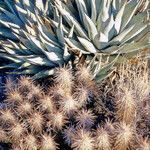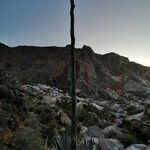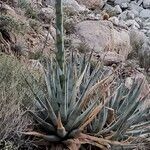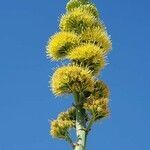Plants acaulescent or short-stemmed, sparsely or prolifically suckering, trunks 0.2–0.4 m; rosettes solitary or numerous, 3–7 × 4–8 dm, compact to rather open. Leaves ascending, widest at base, (20–)25–70 × 4.5–10 cm; blade grayish, gray-or blue-glaucous, yellowish green, or greenish, occasionally cross-zoned, linear-lanceolate to lanceolate, rigid, adaxially concave, abaxially convex; margins straight or undulate to crenate, armed, teeth single, weakly attached, well defined, of 2 types, 2–3 mm or (5–) 6–8 mm, (1–)1.5–3 cm apart; apical spine light or dark brown to gray, subulate to acicular, 2–4 cm. Scape 2–6 m. Inflorescences paniculate, not bulbiferous, open; bracts persistent, triangular, 8–15 cm; lateral branches 6–15, slightly ascending, comprising distal 1/5–1/4 of inflorescence, longer than 10 cm. Flowers 12–48 per cluster, erect, 3–6 cm; perianth yellow, tube shallow, campanulate or funnelform, 3–10 × 9–15 mm, limb lobes wilting soon after anthesis, spreading, equal, 13–20 mm; stamens long-exserted; filaments inserted unequally above middle or at rim of perianth tube, erect, yellow, 2.5–3.5 (–4.2) cm; anthers yellow, 13–21 mm; ovary 1.6–4 cm, neck slightly constricted, 4–6 mm. Capsules short-pedicellate, ovoid to oblong or obovoid, 3.5–5.5 cm, apex beaked. Seeds 5–6 mm.
More
A succulent plant. It can be simple or form clumps. It grows 2.4-4.5 m high and spreads 40-60 cm wide. The leaves are narrow and 15-40 cm long. They are bluish-green to grey and have small sharp teeth along the edge. The flower stalk is 2.4-4.5 m tall. It is branched. The flowers are bright yellow.






